The Quadriceps muscles are one of the largest muscles in your body in terms of muscle size, and you use them in a lot of activities, and accordingly, this constitutes a burden and drive many different pressures on them, and therefore it is preferable to keep practicing the quad stretches exercises every period.
If you want to get a certain body physics, you need to start working on a certain muscle group. This is known as targeted body workouts.
You can engage in different exercises. But if you have plans to work out your Quads Strengthening Exercises and start building these muscles in the most effective way, without exposing yourself or your muscles to any possible injury, it is best to start the right way by stretching the muscles and warming up this part of the body.
In this article, we are going to look at quad extensions in detail, so Let’s Dive into that.
What is the Quadriceps Tendon Muscle?
This refers to a group of four muscles located in the anterior part of your thighs. The Quads is one of the muscles that form part of the thighs. These muscles work with the hamstrings to extend and flex the legs. We intend to use these muscles in our daily activities such as walking, running, jumping and even cycling.
These activities can make the muscles tight and sometimes the strain can be caused by various injuries. This type of injury includes Iliotibial band friction syndrome (ITBS) and spinal stenosis, among others.
There are stretches that help you relieve and build muscle, especially if you’re an athlete. I recommend that you stretch before starting your regular exercise. This will help prevent injuries that may occur during training.
Quad Strain or Quad Pain
It is pain felt on the thighs during or after activity. This can be during running, playing a heavy soccer match, or lifting in squat position. The quad muscles cross the hip and knee joints, making them vulnerable to injuries every time.
An injury occurs when too much tension is placed on the muscles. This, in turn, leads to muscle tearing, a condition known as quad strain. However, you can still get quad strains from simply engaging in activities like jumping, sprinting, and many more.
Symptoms and Signs of Quadriceps Pain
This particular condition also has signs and symptoms to look out for. You should not ignore them, so check with your doctor first before starting any form of exercise. This is because you may be causing more harm than good to the muscles. So make sure not to ignore them.
- You may feel sharp pain when kicking, jumping, running, or climbing stairs.
- The quad muscles will feel stiff and excessively tired.
- You might have difficulty straightening and bending the knee.
- You may also feel sore, swollen, or bruised anterior thigh muscles.
Quad Stretches
This is the remedy to get rid of quadriceps pain. Although I still insist that you consult your doctor before starting to stretch the quads if you have severe pain. Your stretching exercises are a way to release muscle tension.
There are two types of stretching you can choose, either static or dynamic stretching. Dynamic stretching involves movement and includes warm-up exercises such as jumping rope or even jogging on the spot.
On the other hand, a static stretches is an action that does not involve any motions. The type of exercise you choose depends on what you find comfortable and convenient to do.
Here are various exercises that you can do in the gym or even at home.
1) The Frog Pose
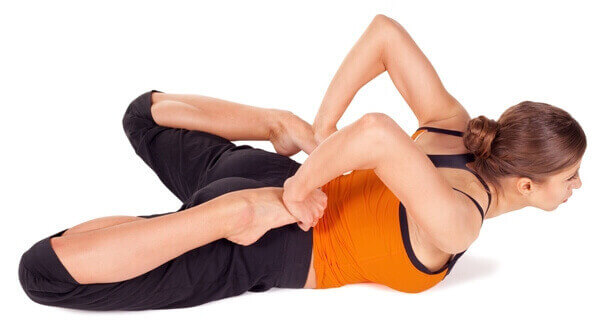
Yoga frog pose, is the ideal exercise as it stretches the thighs and glutes as well. In addition, it also helps stretchs the chest, shoulder blades and arms. The frog exercise does not involve any movements, so you can do it at home without going to the gym.
How to Perform
- Start by lying on your stomach, then prop your torso at the elbows.
- Then bend your knees and extend your hand back to stabilize your feet. At this point, you should start to feel the muscles stretch. If you lack the mobility to do this, I recommend using a towel to fill the space between your hands to hold your feet.
- Afterward, use the palms of your hands to grab your feet from above, at the toes, then carefully raise your elbows to point toward the ceiling. This should be done slowly so that no muscle tissue is bursting.
- Remember to push your chest up as high as you can and then hold this position until you feel pain in your knees or hip. You need to maintain the position for five breaths and then relax. Don’t overdo it, if this is your first time.
2) Standing Quad Stretch
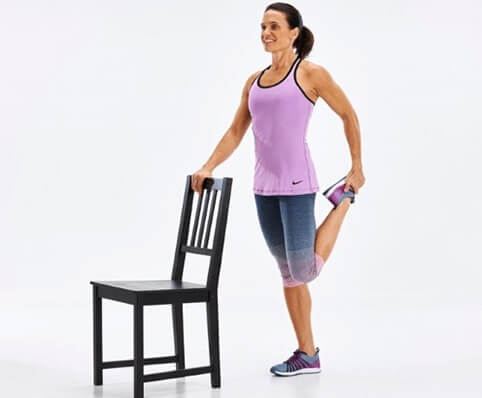
This is a form of static stretching that you can also choose. The workout does not limit you because it can be performed anywhere and anytime. You can do this at home, in the office, or even on the road while walking. As long as you have room to stand, you are good to go.
However, you should stop exercising immediately when you feel sharp pain. This indicates that you are not working your quads correctly or that you have a tissue injury. You can re-workout and if the pain persists, it is best to consult a doctor.
How to Perform
- You can stick to a chair or table for support and balance, if this is your first time. However, over time you will be able to do this without any support. Make sure that you are not fully lean on the chair or table.
- Then bend the knee back and grab your ankle with one hand to be directly behind the gluteus. The knee should be bent as much as possible and hold the position for 30 seconds.
- After 30 seconds, lower the foot on the floor and return to a standing position. Make sure to repeat the exercise 3 to 5 times for each leg.
3) Lying Pigeon Stretch Progression using Band
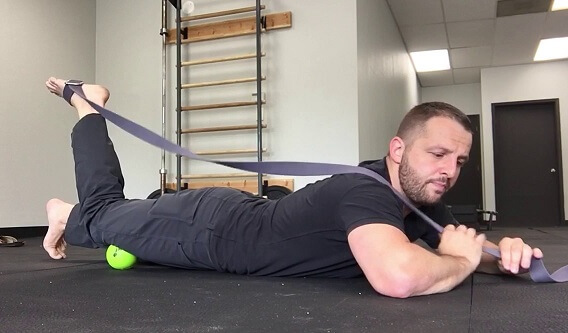
If you enjoy yoga, I am sure you will like this pose. It not only stretches your quads but also your back. Plus it’s a great hip flexor stretch.
How to Perform
- Make sure you lay a mat on the floor and then lie on your belly.
- Then secure a resistance band or a long towel around your left foot, placing the rest of the excess band or towel in an area accessible to your hand.
- Next, grab the towel or band with your left hand but don’t pull it now. Make sure to extend the right leg and then bend your left knee to be behind you. The toes are supposed to be pointing toward the ceiling.
- Pull the band or towel forward until you feel a stretch in the leg muscles. Hold the position for 20 seconds, then pull further as much as you can.
- Return to the starting position, switch to the right leg and repeat the steps.
4) The Kneeling Quad Stretch
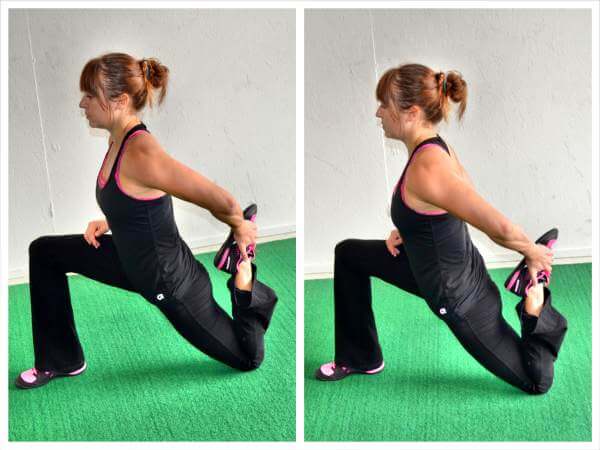
This is a little different from other workouts because it involves loosening the muscles above the knee joint. This special stretch prevents knee pain and increases mobility.
How to Perform
- Place a mat on the floor to protect the knee from a hard surface.
- Begin the stretch in a high lunge position. It could be the right foot or the left foot. However, I’ll start with the right foot lunge forward.
- Then after lunging your feet forward, carefully drop your left knee to the floor. Don’t rush the process because you have to make sure you strike your balance before proceeding.
- Once you have balance, extend your left arm hand back and grab the toes of your left foot or ankle, and lift carefully the foot slightly up. However, this will depend on what you find easier to get than the amount of lift. Hold this position for 30 seconds. Make sure your body is well balanced or else you will have to start the whole process over again.
- Push up slightly if possible to get the hip flexor extended, then return to the starting position.
- Switch to the right foot and start the whole process over again.
5) The Lying Quad Stretch
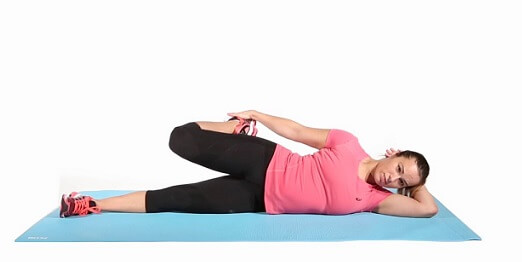
This is a type of stretch that deals with the muscles of the thigh, hip, legs, and feet as well. I would recommend this specific exercise to someone with suffering pain in any of these areas.
How to Perform
- Lay out a mat and lie on your right side depending on what you find comfortable. Then support your head with your right hand.
- Then use the left hand to pull the left foot toward your rear butt and bend your right knee a bit to stabilize and balance your body.
- Hold the ankle and maintain this position for 30 seconds.
- Then return to the starting position and switch to the other side of the left foot.
Avoid the following Mistakes in the Quad Stretch
There are many mistakes you can make without realizing. This is what makes the difference of having ineffective quads. To make sure you’re doing the quads correctly, here are a few things to avoid doing.
(i) Squatting With Incorrect Form
When perform squatting, you are not supposed to lean too far forward and push your hips far backward. Doing so means that you working your hips, butt, and back while forgetting about the quads. In addition, doing the quads in this way leads to problems such as straining the spinal erectors. The best way to make a squatting is through the following:
- If you stand that is more than shoulder width apart, make sure your toes are pointing slightly outward. However, if you are tall, you will need to take a wider stand to be comfortable.
- Look forward as you do each repetition and focus on the arch in your lower back.
- Also, remember to keep your butt above your heels. It will be as if you are about to sit in a chair.
- Then afterward drive out of the hole, while moving your hips. After that you can move your knees.
- Make sure you are in an upright position and not tilted. This can be done by sitting on a bench and squatting in a half-standing and half-sitting position when moving the chair. At this point, I recommend not lifting any weights until you’ve mastered this art.
(ii) Incorrectly Targeting Areas
Most people who do this particular workout do not know how to target the four quadriceps muscles. You will find an individual taking a wide stance who thinks this will work with the inner and outer area of the muscle.
However, this is not the case, since the workout focuses on the inner thigh muscles. The exercise also focuses on the quads and glutes less by moving the feet forward when doing squats.
The best way to properly target the quads area is to do the following:
- Always keep your feet under your hips while exercising. This ensures that you target the quads more and the less for glutes. You should take a narrow stance when exercising. This will focus more on the outer quads.
- Always remember to point your toes inward. This ensures that you increase the performance of the outer quads more. On the other hand, when the toes are pointing outward, it means that you are working the inner quads more.
(iii) Going Too Heavy
This is something we think will work and build their muscle faster, especially in the gym. It could be because you saw someone else lift heavy metals and build muscle. So you want to do the same to be able to work those muscles.
If you see a person squatting and carrying several plates, do not be intimidated. When you start doing this you will feed your ego and you will not build any muscle like what you think. So take your time and start small and work up to the weights, you will eventually build effective muscles.
It would be best to talk to the instructor if you are at the gym, and tell him what your goals are to work on. You can follow this plan at home as well. Always remember to focus on building muscle, not weight.
Verdict
When doing the quads, you need to be specific and focused doing the exercise the right way. No gain without pain, so trust the process. If you find it difficult to do this, you can follow How to Motivate Yourself for Workouts. This will give you a sense of accountability and also boost your morale to keep going.
Quad stretches are one type of exercise that also has benefits that come with it. This includes losing extra calories, improving your body stability among other things. However, if you have any health problem it is necessary to consult your physician before embarking on these exercises. This is because they will advise you if the workout is safe or not.
In the end, remember the different mistakes of performing the quad stretches and try to avoid them to get the most out of these exercises.
